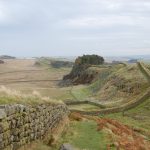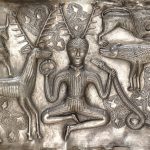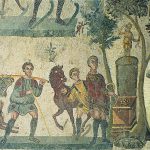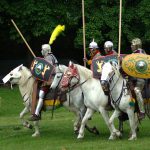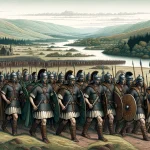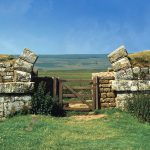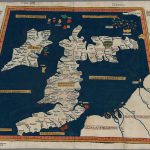High Rochester (Bremenium) Roman Fort
Flavian Auxiliary Fort (AD 69–96)
The Roman fort at High Rochester may initially have been raised in the late first century AD in support of military operations in southern Scotland. It was the most important outpost north of Hadrian’s Wall. It could warn of attacks from the north. The Roman fort of Bremenium’s name means “the place on the roaring stream”.
The Stages of the Roman Fort at Bremenium (High Rochester)
The Agricolan Fort 78AD/85AD
The fort was located on what would later become known as Dere Street, the main overland route north on the eastern side of Britain, it was a strategically important point as evidenced from a number of Roman marching camps to the north-west of the fort. As the Romans consolidated their hold on southern Scotland, a semi-permanent presence at High Rochester may have been deemed beneficial. The fort was built of turf with a wooden parasite and demolished following the abandonment of Scotland.
Antonine Fort from AD 139
The fort was rebuilt (or built) circa-AD 140 as the Roman army returned to Scotland. Although Hadrian’s Wall had been built around AD 122, the accession of Emperor Antoninus Pius meant the Romans moved north to the Clyde/Forth isthmus where they built the Antonine Wall. Dere Street ran north to that frontier (and beyond) and High Rochester served as an outpost along that vital communication artery. Known to the Romans as Bremenium (which translates as “fort on the roaring stream”), it guarded the key logistical route from the major town at Corbridge to the new frontier. It was built of rubble with clay rampart inside.
There appears to be no occupation during Hadrian’s reign, although there is no evidence it probably remained occupied for the rest of the 2nd century.
Severan Period
In the Severan Period the existing fort was demolished a new fort built. The rebuilding of the fort would have been part of a major refurbishing of the Wall undertaken in the first years of the 3rd There appears to have been a greater importance given to the outlying forts north and south of the Wall giving strength in depth.
What did Bremenium (High Rochester) Fort look like?
Like most Roman forts of the period, High Rochester was configured in a playing card layout shape with a headquarters in the centre and barracks in each quadrant. High Rochester. A squarish oblong fort of 4 acres; very thick stone rampart with clay core, stone inner buildings; on the north, remains of as many as thirteen ditches; on east and south, four; on west, uncertain, but six ditches curve round N.W. angle (personal observation)
Visiting Bremenium (High Rochester) Fort
It is approached from the A68 through the grounds of the Brigantium Archaeological Reconstruction Centre. Almost the entire defensive circuit of the fort is preserved, with the remains of the western gateway being particularly fine also evidence of several periods of rebuilding in the western interval-tower of the south side. The ditches are well preserved to the north and east, outside which the line of Dere Street marches north-west, passing the temporary camps at Redesdale, visible across the Sills Burn from the fort’s western ramparts. Between the ramparts the fort measures around 440 ft north-south by about 420 ft east-west, giving an occupation area of about 4¼ acres (c.134 x 128 m; c.1.7 ha).
Classical References to Bremenium / Bremenivm
The name of this fort is attested in three of the four major geographical sources, its absence from the Notitia Dignitatum of the late fourth century indicates that by then, the province had receded behind Hadrian’s Wall to the south. The Bremenium entry in Geography of Ptolemy appears along with two other towns attributed to the Otalini (or Votadini) tribe; Corstopitvm (Corbridge, Northumberland) and Alavna (Learchild, Northumberland). The Antonine Itinerary places Bremenium at the start of Iter I, listed twenty miles from Corstopitum. The last classical reference for Bremenium appears in the Ravenna Cosmology (R&C#185), where it is listed between Habitancvm (Risingham, Northumberland) and the unidentified Coccimeda entry.
The Bremenium Garrison
RIB 1276 - Dedication-slab
For the Emperor Caesar Titus Aelius Hadrianus Antoninus Augustus Pius, father of his country, under Quintus Lollius Urbicus, emperor’s propraetorian legate, the First Cohort of Lingones, part-mounted, built this.
H[...]D ANTONINO AVG PIO P P
SVB Q LOL VRBICO
LEG AVG PRO PRAE
COH I LING
EQ F
No commentary.
The First Cohort of Lingones is known from inscriptions here at Bremenivm (High Rochester, Northumberland; RIB 1276; 139-43AD), Longovicivm (Lanchester, Durham; RIB 1091/1092; 238-44AD), and possibly also at Corstopitvm (Corbridge, Northumberland; RIB 1186; undated) unfortunately missing the unit number.
RIB 1279 - Dedication-slab
For the Emperor Caesar Marcus Aurelius Severus Antoninus Pius Felix Augustus, Most Great Conqueror of Parthia, Most Great Conqueror of Britain, Most Great Conqueror of Germany, pontifex maximus, in his nineteenth year of tribunician power, twice acclaimed imperator, four times consul, proconsul, father of his country, the First Loyal Cohort of Vardulli, Roman citizens, part-mounted, one thousand strong, Antoniniana, built this under the charge of …, emperor’s propraetorian leg
SEVERO ANTONINO
PIO FELICI AVG PARTHIC
MAX BRIT MAX GERM
MAX PONTIFICI MAXIM
TRIB POTEST XVIIII IMP II
COS IIII PROCOS P P COH I
FIDA VARDVL C R EQ ↀ ANTO
NINIANA FECIT SVB CVRA ⟦[c..]⟧
⟦[c. 13]⟧ LEG AVG PR P[...]
6. A.D. 216, under Caracalla. 9-10. The name of the legate, which here is erased, seems to survive in part on RIB 1049 (Chester-le-Street); Birley, in Askew Coinage, 82, restores this as [m · ant(onivs) gor]dianvs.
The name of this particular unit appears on over twenty percent of the inscriptions recovered from this site, including at least one building inscription (RIB 1285; not shown), which proves that some restoration work was undertaken at High Rochester during the early campaigns of Severus into Scotland at the beginning of the third century AD.
The First Cohort of Vardulli is attested at several forts in the north of Britain; at Castlecary (Central; RIB 2149; 138-61AD) on the Antonine Wall, at Longovicivm (Lanchester, Durham; RIB 1083; c.175-8AD) and here at Bremenivm (High Rochester, Northumberland; RIB 1279; 216AD). There are also undated inscriptions at Corstopitvm (Corbridge, Northumberland; RIB 1128) on the Stanegate, at milecastle 19 on Hadrian’s Wall (RIB 1421) nearby, and at Cappuck (Borders; RIB 2118) on Dere Street.
RIB 1289 - Funerary inscription for Aurelius Ex[....]imi
Sacred to the spirits of the departed (and) of Aurelius Ex[…]imi, centurion of the First Cohort of Dalmatians (or Dacians).
AVRELI EX[4]
IM[...] 𐆛 COH I DA[...]
No commentary.
This unit is attested on only one inscription from the site, which is possibly only a passing reference:
“To the spirits of the departed and to Sextus Aurelius former [unknown], (former)¹ Imaginifer,² centurion of the First Cohort of Dalmatians.”³
(RIB 1289; tombstone)
- The lacuna in the text is discussed below.
- Bearer of the Emperor’s Image; a privileged position high in the command structure.
- Or possibly DAC[orum], from the province of Dacia, modern Serbia / Eastern Bosnia.
The curriculum vitae of a Roman soldier or Magistrate appeared on his epitaph in reverse order, with the highest-achieved position being listed first. The finest achievement of Sextus Aurelius has been lost, but would have to be higher in rank than the next legible position, which was Imaginifer, presumably of Cohors I Dalmatarum. The missing text may well have read EX Tribunus Cohortis I Vardullorum, alternately, the obliterated portion may possibly refer to his place of birth.
Numerus Exploratorum Bremeniorum
RIB 1262 - Altar dedicated to Genius of our Lord and of the standards of the First Cohort of Vardulli and of the Unit of Scouts of Bremenium
To the Genius of our Lord and of the standards of the First Cohort of Vardulli and of the Unit of Scouts of Bremenium, styled Gordianus, Egnatius Lucilianus, emperor’s propraetorian legate, (set this up) under the charge of Cassius Sabinianus, tribune.
SIGNORVM
COH I VARDVL[...]
ET N EXPLORA
TOR BREM GOR
EGNAT LVCILI
ANVS LEG AVG PR PR
CVRANTE CASSIO
SABINIANO TRIB
For Egnatius Lucilianus see RIB 1091 (Lanchester). He governed Britannia Inferior just before, or just after, Maecilius Fuscus (RIB 1092, Lanchester) within A.D. 238-41 (Birley in Askew Coinage).
RIB 1270 - Dedication to the Goddess Rome
Sacred to the goddess Rome. The duplicarii of the unit of Scouts of Bremenium set up this altar on her birthday under the charge of Caepio Charitinus, tribune, willingly and deservedly fulfilling their vow.
DVPL N EXPLOR
BREMEN ARAM
INSTITVERVNT
N EIVS C CAEP
CHARITINO TRIB
V S L M
2. For duplicarii see Glossary. 5. Natali Urbis Romae: 21 Apr. (see Hoey loc. cit.).
The only dateable pottery evidence recovered from the High Rochester fort is a single piece of South Gaulish Form 37 dated to the 80AD’s. During excavations over the years a number of animal bones have been uncovered, including those of Ox, Sheep, Pig, Red Deer, Roe Deer, Boar, Hare, Fox and Badger; the latter two animals very likely being hunted and killed for sport and as a means of pest control.
Other Roman Sites in the Neighbourhood
There is another Roman fort a little way down Dere Street to the south at Blakehope (NY8594). There are also a number of temporary marching camps in the Bremenium area; six near High Rochester itself at Birdhope, Bellshiel and Sills Burn, one at Yardhope (NT9000) along the road to Alauna (Learchild) in the east, another at Bagraw (NY8496) off Dere Street to the south, and one more at Dargues (NY8693) beyond the Blakehope fort to the south, again near Dere Street.
References for Bremenivm
- The Archaeology of Roman Britain by R.G. Collingwood (Methuen, London, 1930);
- The Roman Inscriptions of Britain by R.G. Collingwood and R.P. Wright (Oxford 1965);
- The Romans in Britain – An Anthology of Inscriptions by A.R. Burn (Blackwell, Oxford, 1969);
- The Roman Military Diet by R.W. Davies, in Britannia ii (1971) pp.122-142;
- The Roman Occupations of Scotland by B.R. Hartley in Britannia iii (1972) pp.1-55;
- Chronology of the Ancient World by E.J. Bickerman (Thames & Hudson, London, 1980);
- Roman Britain – A Sourcebook by S. Ireland (Routlege, New York, 1986);
- Chronicle of the Roman Emperors by Chris Scarre (Thames & Hudson, London, 1995)
Map References for Bremenivm
NGRef: NY8398 OSMap: LR80
Roman Roads near Bremenivm
SE (2) to Bagraw SSE (3) to Blakehope (Northumberland) NNW (8) to Chew Green (Northumberland) ENE (19) to Learchild (Learchild, Northumberland) Dere Street: SSE (10) to Risingham (Risingham, Northumberland) ENE (5) to North Yardhope
Sites near High Rochester (Bremenium) Roman Fort
- Birdhope Camps (1 km)
Marching or Temporary Camp - Sills Burn South Marching Camp (1 km)
Marching or Temporary Camp - Sills Burn North Marching Camp (2 km)
Marching or Temporary Camp - Bellshiel Camp (2 km)
Marching or Temporary Camp - Silloans Marching Camp (2 km)
Marching or Temporary Camp - Bagraw Camp (3 km)
Marching or Temporary Camp - Blakehope Roman Fort (5 km)
Trajanic Auxiliary Fort (A.D. 98–117) - Dargues Marching Camp (6 km)
Marching or Temporary Camp - North Yardhope Marching Camp (8 km)
Marching or Temporary Camp - Chew Green Camp 4 (11 km)
Marching or Temporary Camp
